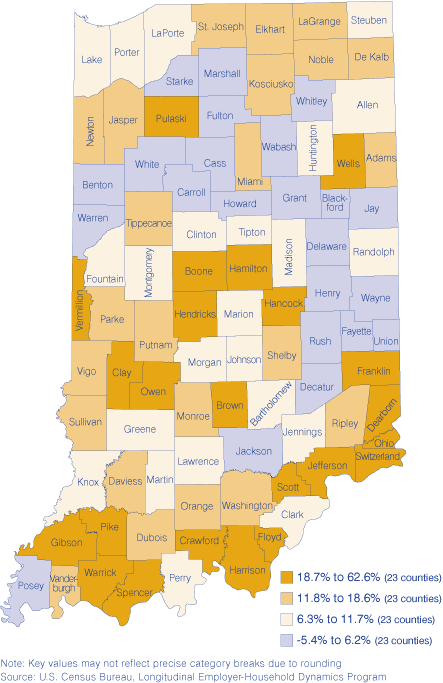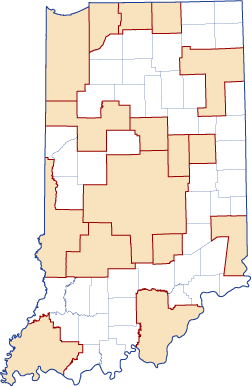Aging and Still At It: Older Workers in Indiana
About 14 percent of workers in Indiana were 55 and older in 2004, according to the most recent Older Worker Profiles from the U.S. Census Bureau Local Employment Dynamics (LED) program.1 Why does this matter, and why such an emphasis on the older workforce across the state and nation? Demographic changes can affect how government programs are designed and how businesses deal with pensions and retirement.
This article highlights data from Indiana's Older Worker Profile, which was released late-2007 and relies on 2004 data, to provide some insight into Indiana's older workers. This article will focus on two groups of older workers: those who may be receiving pension income but who are working (65 and older) and a pre-retirement group of workers, who may start collecting pensions and social security over the next decade (workers 55 to 64).
Of Indiana's 92 counties, 90 saw an increase in the percent of the county workforce that was 55 and older. Figure 1 shows that 23 counties had an increase in the older workers by at least 18.7 percent. Ohio County ended up with the highest proportion of older workers in 2004, where one in every five workers was 55 or older.
Figure 1: Percent Change in the Number of Workers 55 and Older by County of Workplace in Indiana, 2001 to 2004

Jobs by Industry
What kinds of jobs are these older workers doing? Many are instructing and training in schools, colleges, universities and training centers. When looking at each individual industry sector, educational services had the highest proportion of workers in the 55 and older age group among industry sectors that employed at least 100 workers 55 and older. Overall, however, the manufacturing industry was most likely to employ older workers in 2004. Of all the workers in Indiana 55 and older, one in every four was employed in manufacturing.
Across the state, workers 55 and older earned an average of $3,237 per month. Looking once again at industry sectors that employ at least 100 workers 55 and older, management of companies and enterprises paid the most, averaging $6,461 per month (see Table 1).
Table 1: Average Monthly Earnings for Workers 55 and Older, 2004
| Industry | Earnings |
| Management of Companies and Enterprises | $6,461 |
| Utilities | $5,133 |
| Finance and Insurance | $4,709 |
| Mining | $4,343 |
| Professional, Scientific and Technical Services | $3,893 |
| Wholesale Trade | $3,771 |
| Construction | $3,619 |
| Information | $3,506 |
| Educational Services | $3,136 |
| Health Care and Social Assistance | $3,081 |
| Transportation and Warehousing | $2,988 |
| Agriculture, Forestry, Fishing and Hunting | $2,524 |
| Real Estate, Rental and Leasing | $2,239 |
| Administrative, Support and Waste Management | $2,018 |
| Arts, Entertainment and Recreation | $1,975 |
| Other Services (Except Public Administration) | $1,964 |
| Retail Trade | $1,877 |
| Accommodation and Food Services | $1,279 |
Source: U.S. Census Bureau, Longitudinal Employer-Household Dynamics Program
Metro Counties

- About 14.2 percent of the workforce was 55 and older in 2004.
- Educational services employed the highest percentage of workers 55 and older (20.9 percent of its total workforce).
- Agriculture, forestry, fishing and hunting employed the highest percentage of workers 65 and older (6.6 percent of its total workforce).
- 22.7 percent of all workers 55 and older were employed in manufacturing.
- The highest paying industry with at least 100 employees among workers 55 and older in metro counties was management of companies and enterprises, which paid an average $7,014 per month. The lowest paying industry, accommodation and food services, paid an average $1,304 per month.
Nonmetro Counties

- Of the total workforce in nonmetro areas, 15.5 percent was 55 and older.
- Real estate, rental and leasing employed the highest percentage of workers 55 and older (21.5 percent of its total workforce).
- Other services (except public administration) had the highest percentage of workers 65 and older (7.9 percent of its total workforce).
- 33 percent of all workers 55 and older were employed in manufacturing.
- The highest paying industry with at least 100 employees among workers 55 and older in nonmetro counties was utilities, which paid an average $4,815 per month. Similar to metro counties, accommodation and food services paid the least, and even less in nonmetro counties ($1,207 per month).
Notes
- Cynthia Taeuber and Matthew R. Graham, "The Geographic Distribution of and Characteristics of Older Workers in Indiana: 2004," October 2007. Available online at www.census.gov/library/publications/2007/econ/led-ow-in.html.
Molly Manns, Associate Editor
Indiana Business Research Center, Kelley School of Business, Indiana University
